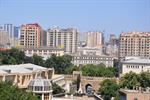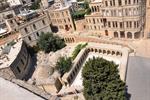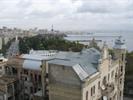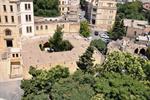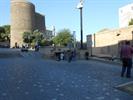Paris has it's Eiffel Tower. In Moscow, St. Basil's Cathedral draws them in. In Rome, it's the Colosseum. Athens, its Acropolis. And in Baku-the distinguishable architectural landmark is none other than the Maiden Tower. Azerbaijanis are incredibly proud of this monument that is shrouded in mystery and legend even though scholars and historians are unable to speak with absolute authority about its origins.
Unique in world architecture, this ancient, almost windowless, eight-storey fortress was reconstructed in the 12th century but may have started life as a fire beacon and lookout post as long ago as 500 BC.
Measuring nearly 30m tall and around 16m in diameter, Maiden Tower was once the largest and most impressive building in Azerbaijan. Its century of construction is the subject of much debate, though its present form is 12th century. The Azeri name, Qyz Qalasy, is usually rendered ‘maiden’s tower’ in English, leading to plenty of patently fictitious fairy-tales. A better translation of Qyz Qalasy would be ‘virgin tower’, alluding to military impenetrability rather than any association with tragic females.
Why is it called Maiden Tower?
The question everyone asks is, "why is it called Maiden Tower?" Well, many legends surround the name. Most of them center around the word-"Maiden." According to one of the most popular legends, a wealthy ruler falling in love with his own daughter and wanted to marry her. Revolted by the thought of incest but unable to disobey her father she stalls, commanding that he build her a tower high enough to survey the full extent of his domain before she decides.
When he completed it, he had still not changed his mind. So she climbed to the top and that's when she leaped into the sea. As the level of the Caspian Sea has experienced cycles of fluctuation-rising and falling-over the centuries, there is a strong possibility that at one time, the waves did lap at the Tower although today the sea is about a block away (observations show it is getting closer and closer again).
Another story goes the a King used to lock up his virgins in the tower, and would request their "services" when he would visit his Hammam at the base of the tower. Yet another story goes that Baku has never actually been taken in a war, thus it's a "virgin" tower. There are countless other tales and legends, which is part of the allure. Whatever the reason for the name, it's still one of the better things to see while visiting Baku. And at only 2 Manat, it's an absolute bargain when compared to other things in the city.
An alternative version accuses Khunsar, the legendary founder of Baku, of locking his guiltless sister in the tower. She threw herself to her death and as retribution God drowned Khunsar's great pastures and created the Caspian Sea.
In fact the term Qiz Qalasi has nothing whatever to do with young, abused female relations. It is a name quite commonly applied to fortress towers - virginity coming from the fact that it was never penetrated by the various attackers who besieged it throughout history. True or not, the name gave defenders of such towers a certain feeling of invincibility.
Maiden Tower's architectural plan, seemingly so simple, consists of walls which at the base are extraordinarily thick, beginning at five meters in depth and gradually narrowing to four meters at the top. Today, dwarfed by the emergence of skyscrappers, it still manages to retain it's status of Azerbaijan's unofficial symbol. It is on the national currency, gracing the back of the 10 Manat bill and the 5 Qapik coin. Not to mention countless seals and coat of arms. It lies at the heart of Baku's Old city and is listed on UNESCO's (http://whc.unesco.org/en/list/958) world heritage list
Historians agree that it has served as a defensive tower; beyond that some claim it was also a lookout post, a fire beacon, a Zoroastrian tower of silence or even an astronomical observatory. It was certainly an incredibly massive structure for
its era, with walls 5m thick at the base and an unusual projecting buttress. Openings on the south side permit light to enter. The eight floors are linked by steps within the walls, except for the ground floor, where a retractable ladder has now been replaced by a modern iron staircase. A deep well descends from a recess in the 2nd-floor chamber. A mysterious doorway on the 3rd floor opens into thin air; its original function (possibly astronomical) remains unknown.
Today, the interior contains an interesting display of old photographs and a souvenir shop, but the highlight is the superb rooftop viewpoint surveying Baku Bay and the Old City. The views from the top are worth the climb, with a sweeping panorama of the Old City, the new skyscrappers on the hills and the Caspian Sea.
If you're planning a trip to Baku you may need: 1) A wide selection of accommodation options in Baku (basic hostels, budget hotels for unpretencious travelers, small size family run hotels, international business hotel chains). 2) Practical information for tourists (visa regime, prices, best time to vizit and etc). Please do not hesitate to contact us for consultation





